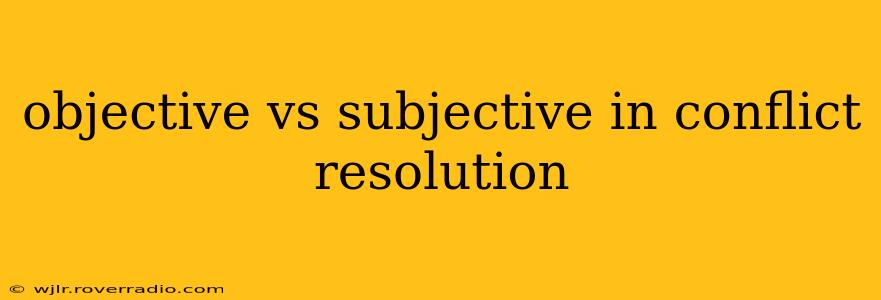Conflict is inevitable in any relationship, whether personal or professional. Successfully navigating these disagreements hinges on understanding the difference between objective and subjective perspectives and employing strategies that leverage both. This article explores the crucial role of objectivity and subjectivity in conflict resolution, offering practical insights for achieving mutually beneficial outcomes.
What is Objective Conflict Resolution?
Objective conflict resolution focuses on the facts of the situation, separating them from emotions and personal interpretations. It prioritizes verifiable information, neutral data, and observable actions. Think of it as looking at a conflict through a detached, analytical lens. This approach emphasizes:
- Identifying the problem: Clearly defining the issue at hand without emotional bias. What happened? What are the tangible consequences?
- Gathering evidence: Collecting factual data relevant to the conflict. This might involve reviewing documents, timelines, or witness accounts.
- Neutral evaluation: Assessing the situation impartially, avoiding assumptions or personal judgments.
- Finding common ground: Focusing on shared goals and identifying areas of agreement, despite differing perspectives.
What is Subjective Conflict Resolution?
Subjective conflict resolution acknowledges the emotions and perspectives of individuals involved. It recognizes that conflict is rarely simply about facts; it's also about how those facts make people feel and what those feelings mean to them. This approach requires:
- Active listening: Empathetically hearing and understanding each party's viewpoint, including their feelings and concerns.
- Validating emotions: Acknowledging and respecting the emotional experiences of those involved, even if you don't necessarily agree with their interpretations.
- Exploring underlying needs: Identifying the unmet needs or desires that are driving the conflict. Often, the surface-level disagreement masks deeper issues.
- Finding creative solutions: Brainstorming solutions that address the emotional and practical aspects of the conflict.
How to Balance Objective and Subjective Approaches
The most effective conflict resolution strategies blend both objective and subjective approaches. A purely objective approach can feel cold and impersonal, failing to address the emotional core of the conflict. Conversely, a purely subjective approach might ignore the factual realities of the situation, hindering progress toward a resolution.
Here's how to strike a balance:
- Start with objectivity: Begin by clearly defining the problem and gathering relevant facts. This provides a solid foundation for further discussion.
- Embrace subjectivity: Once the facts are established, actively listen to and validate the emotions and perspectives of each party involved.
- Bridge the gap: Use objective facts to address subjective concerns. For example, if someone feels undervalued, present objective data demonstrating their contributions.
- Collaborate on solutions: Work together to develop solutions that address both the factual realities and the emotional needs of everyone involved.
Is it possible to be completely objective in conflict resolution?
Can complete objectivity be achieved in conflict resolution?
While striving for objectivity is crucial, complete objectivity is virtually impossible. Our personal experiences, biases, and values inevitably influence our perception of any situation. The key is to acknowledge these biases and actively work to mitigate their influence on our judgment.
How can I identify my own biases in conflict resolution?
Identifying personal biases in conflict resolution
Self-reflection is key. Consider your past experiences, cultural background, and personal values. Are you more likely to sympathize with certain types of people or perspectives? Becoming aware of these biases allows you to approach conflicts with greater self-awareness and make a conscious effort to remain impartial.
What are some common subjective biases that can affect conflict resolution?
Common subjective biases affecting conflict resolution
Common biases include confirmation bias (seeking out information that confirms existing beliefs), anchoring bias (over-relying on the first piece of information received), and affinity bias (favoring individuals similar to oneself). Recognizing these biases is the first step towards mitigating their impact.
Conclusion: The Power of a Balanced Approach
Mastering both objective and subjective approaches to conflict resolution is a powerful skill. By balancing factual analysis with empathetic understanding, you can navigate disagreements effectively, foster stronger relationships, and achieve mutually beneficial outcomes. Remember that the goal is not necessarily to "win" the argument, but to find a resolution that respects the needs and perspectives of all parties involved.
